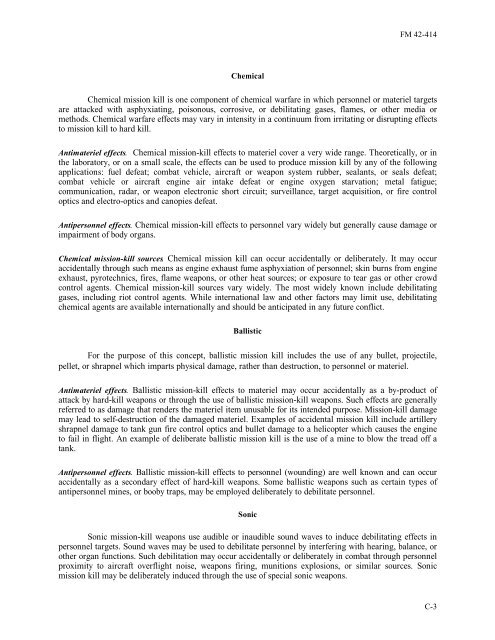Tactics, techniques, and procedures for - Army Electronic ...
Tactics, techniques, and procedures for - Army Electronic ...
Tactics, techniques, and procedures for - Army Electronic ...
You also want an ePaper? Increase the reach of your titles
YUMPU automatically turns print PDFs into web optimized ePapers that Google loves.
Chemical<br />
FM 42-414<br />
Chemical mission kill is one component of chemical warfare in which personnel or materiel targets<br />
are attacked with asphyxiating, poisonous, corrosive, or debilitating gases, flames, or other media or<br />
methods. Chemical warfare effects may vary in intensity in a continuum from irritating or disrupting effects<br />
to mission kill to hard kill.<br />
Antimateriel effects. Chemical mission-kill effects to materiel cover a very wide range. Theoretically, or in<br />
the laboratory, or on a small scale, the effects can be used to produce mission kill by any of the following<br />
applications: fuel defeat; combat vehicle, aircraft or weapon system rubber, sealants, or seals defeat;<br />
combat vehicle or aircraft engine air intake defeat or engine oxygen starvation; metal fatigue;<br />
communication, radar, or weapon electronic short circuit; surveillance, target acquisition, or fire control<br />
optics <strong>and</strong> electro-optics <strong>and</strong> canopies defeat.<br />
Antipersonnel effects. Chemical mission-kill effects to personnel vary widely but generally cause damage or<br />
impairment of body organs.<br />
Chemical mission-kill sources. Chemical mission kill can occur accidentally or deliberately. It may occur<br />
accidentally through such means as engine exhaust fume asphyxiation of personnel; skin burns from engine<br />
exhaust, pyrotechnics, fires, flame weapons, or other heat sources; or exposure to tear gas or other crowd<br />
control agents. Chemical mission-kill sources vary widely. The most widely known include debilitating<br />
gases, including riot control agents. While international law <strong>and</strong> other factors may limit use, debilitating<br />
chemical agents are available internationally <strong>and</strong> should be anticipated in any future conflict.<br />
Ballistic<br />
For the purpose of this concept, ballistic mission kill includes the use of any bullet, projectile,<br />
pellet, or shrapnel which imparts physical damage, rather than destruction, to personnel or materiel.<br />
Antimateriel effects. Ballistic mission-kill effects to materiel may occur accidentally as a by-product of<br />
attack by hard-kill weapons or through the use of ballistic mission-kill weapons. Such effects are generally<br />
referred to as damage that renders the materiel item unusable <strong>for</strong> its intended purpose. Mission-kill damage<br />
may lead to self-destruction of the damaged materiel. Examples of accidental mission kill include artillery<br />
shrapnel damage to tank gun fire control optics <strong>and</strong> bullet damage to a helicopter which causes the engine<br />
to fail in flight. An example of deliberate ballistic mission kill is the use of a mine to blow the tread off a<br />
tank.<br />
Antipersonnel effects. Ballistic mission-kill effects to personnel (wounding) are well known <strong>and</strong> can occur<br />
accidentally as a secondary effect of hard-kill weapons. Some ballistic weapons such as certain types of<br />
antipersonnel mines, or booby traps, may be employed deliberately to debilitate personnel.<br />
Sonic<br />
Sonic mission-kill weapons use audible or inaudible sound waves to induce debilitating effects in<br />
personnel targets. Sound waves may be used to debilitate personnel by interfering with hearing, balance, or<br />
other organ functions. Such debilitation may occur accidentally or deliberately in combat through personnel<br />
proximity to aircraft overflight noise, weapons firing, munitions explosions, or similar sources. Sonic<br />
mission kill may be deliberately induced through the use of special sonic weapons.<br />
C-3

















